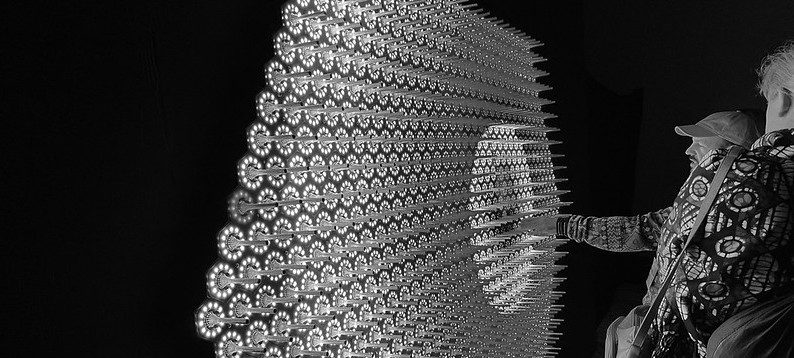Notes from SXSW 2023

SXSW always warps the brain in weird and wonderful ways, and this year was no exception. In some ways this felt like a return to reality following the giddy optimism of last year’s SXSW, with all that’s happened in the world of tech since then. The crash of crypto, the unfulfilled promises of NFTs and VR, the mass layoffs and the twitter purchase by Elon Musk took a lot of wind out of sails before the event, and then the collapse of Silicon Valley Bank (on day one of SXSW!) was a cautionary tale for anyone trying to make a quick buck.
That isn’t to say there weren’t some positive overtones. I’ve always felt that a more sceptical (and, yes, pragmatic) view of the world harbours the greatest long term potential, and there was plenty of that to be found.
If you’d like to jump straight to the photo album, you can find it here on Flickr.
Chatting about chat
The subject of AI was rarely far from the conversation, given the recent explosion of text based and graphical tools as well as the launch of ChatGPT v4 while SXSW was underway. I’m already on record as something of a sceptic - at least in the short term - when it comes to the current crop of releases, and I gravitated towards those speakers who might bring a seasoned perspective to the table. Kevin Kelly of Wired came up with what I think is the best way to think about the emerging chat space; that we’ll treat them like a “Universal Personal Intern” - a way to get started quickly, that requires expert intervention to finish the job. We can anticipate a period of steady improvement of course, but until such time as AI can synthesise deductive reasoning, or develop situational awareness, many knowledge worker jobs will remain safe.
Drop me a line if you’d like to explore using ChatGPT or other AI tools in your business, I’m keen to explore this stuff with like minded folks.
Brain Computer Interfaces (BCIs)
I attended a couple of sessions on the subject of BCI, and again it was refreshing to find that folks weren’t just talking about potential but were openly discussing barriers to progress and demonstrating hard-earned success.
One panel member provided a great analogy for BCI. Putting sensors outside the skull is a bit like standing outside a stadium and trying to work out what’s going on from sounds made by the crowd. Sensors under the skull but on the surface of the brain are like being in row z, whereas actually embedding sensors inside the brain gets you court-side. It’s the only way to directly read the electrical signals in an accurate way. The dangerous and invasive surgery will always mean this isn’t open to everyone - we need not fear the rise of super-soldiers just yet.
What made this panel stand apart was that three of the participants had actually undergone this surgery following serious accidents causing varying levels of paralysis.

All three of these pioneers had been involved in various experiments doing everything from controlling robots and computers to restoring partial function to their hands. Actually useful stuff that will eventually pave the way for other people suffering from paralysis. One of them even drew a painting and sold it as an NFT for 2.5 ETH (approx. US$1,800 in today’s money)!
Climate Repair, Ocean Health, and Carbon Removal
While there are now good-news stories every day about the transition to clean energy, it’s far too early to celebrate. Here are some not-so-fun facts:
- 14 Zetajoules of excess energy have already been captured in the ocean since 1901
- Because of the amount of carbon in the atmosphere, an equivalent of 7 Hiroshimas of energy are put into the ocean every second (!)
- A total of 700 billion tonnes of co2 have been put into the ocean so far. The nature of this is such that it has increased surface-level acidity by 30%
- The crab industry in Alaska collapsed this year
- In Maine, all the mackerel have gone North to escape the warm water
We should of course keep doing our best to transition across to clean energy, but we must now also turn our attention to carbon removal. We need to clean up 100-1,000 Gigatonnes of co2 this century.
I attended a fascinating panel about one potential solution. While heating the ocean is obviously bad, it would actually be good to put more carbon in there, out of our atmosphere, so long as it doesn’t stay on the surface. In fact, the ocean is already set up to remove carbon from our atmosphere, and we can take steps to accelerate this process.

Of particular interest was the notion that we should grow more carbon on the surface (seaweed, which consumes carbon dioxide) which sinks when it dies. None of this is as simple as the diagram suggests, but it provides some comfort that smart people are not just thinking about this, they’re taking action.
The Science and Ethics of De-Extinction
One of the more surprising panels was one discussing de-extinction. First, they bust a few myths - as soon as a creature dies, the DNA in the cells start to degrade thanks to radiation and other factors. We’re not going to be bringing back dinosaurs anytime soon. Even if we could, you can’t replicate the animal exactly - we’re all the subject of our environment (especially in utero) as well as our genome, and those conditions no longer exist.
But what we can do is capture DNA fragments from the crushed bones of more recently deceased animals, like a wooly mammoth who died 11,000 years ago. We can then superimpose elements of that DNA on top of a living creature’s DNA, such as an elephant, to bring back traits of the original animal. This might manifest as, for example, an elephant that can withstand cold weather.
The ethical aspects were fascinating. Of course we have the famous quote by Dr.Ian Malcolm in Jurassic Park, “Your scientists were so preoccupied with whether they could, they didn’t stop to think if they should”. But when we’re talking about potentially restoring animals or plants where mankind played a role in their extinction, perhaps we have an obligation to try and bring them back? Who gets to decide what gets bought back? How far back should we go?
One panelist is already heavily involved in trying to bring back the American Chestnut Tree, which was eradicated in the 1890s due to a fungus blight being introduced by humans. In fact, people have been trying to work out how to bring back the chestnut since it was eradicated. Several government departments are weighing in; the Environmental Protection Agency, US Dept of Agriculture, and Food and Drug Administration to name but three. There’s no single coordinated framework for controlling this process and also no shortage of people who are dead set against genetic manipulation in any form. Nonetheless, the panelist confidently predicted that the American Chestnut will return in the next two years.
Checking in on Hyperloop
Talking of giddy optimism, mine was certainly on display when the Hyperloop was being kicked around by Elon Musk back in 2013, so I was curious to see how the various teams were handling a decade of setbacks. Long story short: not well, but the idea isn’t dead yet. Most of the engineering challenges have been overcome, although the most promising solution will cost $350m per mile - lots of coils for power and orientation, and some infrastructure needs to be kept at absolute zero. This leaves significant political problems when it comes to funding, land ownership, and powerful lobbies and vested interests who want to leave things the way they are. These challenges appear to be slightly less onerous in Europe than in the States, so more progress is being made there - but it’s heavy going. Don’t hold your breath.
Perhaps as with AI it’s better to thing of these nascent technologies as a slow burn. Why do we measure success in such short time frames? Just because some technologies burst onto the scene quickly, doesn’t mean they all should. Maybe in 50 years time we’ll all be taking hyperloops. It’s a nice thought.
Everything everywhere
Despite most of the TV production companies slashing back on budgets, things were pretty optimistic over in the film track, buoyed by the Oscar haul by Everything Everywhere All At Once (which premiered at last year’s SXSW). 2023 has been the first year I’ve had access to the film track, and it was fun to attend a bunch of film and TV premieres with all the associated hullaballoo. Highlights included:
- Premieres of TV shows Shatter Belt (a bit like The Twilight Zone), Mrs.Davis (bonkers show from Damon Lindelof of ‘Lost’ fame, promoted by dozens of nuns wandering around Austin) and Beef (new comedy drama about road rage), all worth a watch
- Premiere of Evil Dead Rise, the fifth film in the franchise. Nice to see some Aussies (Lily Sullivan and Alyssa Sutherland) taking the stage, and Bruce Campbell was hilarious as always
- Premiere of Air, the new biopic about the advent of Nike’s Air Jordan. Matt Damon, Ben Affleck, Viola Davis and more in attendance. Great buzz!
Footnotes
As usual there were far too many other things to write about at length. But a few bullet points stood out:
- Went to see New Order, they were terrific and they played just Joy Division songs for their encore. Nice touch.
- William Shatner in the flesh! He was hilarious…didn’t think it was possible to love him more than I did before, but here we are!
- Popped down to Houston to visit the Space Center and catch a Rockets game (they lost)
- Some truly awesome music on the final night by The Nude Party (here’s a choice track), and Shaun Thompson’s Weird Ears
That’s a wrap for SXSW for another year!
